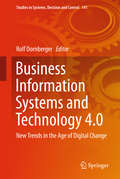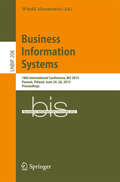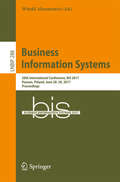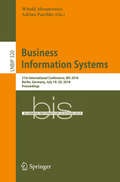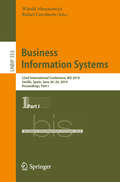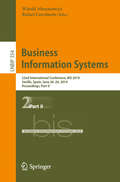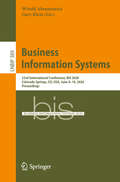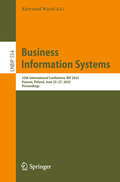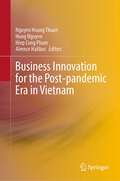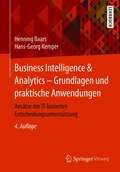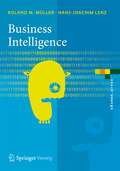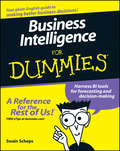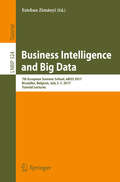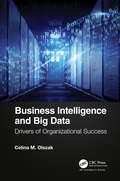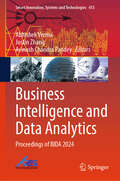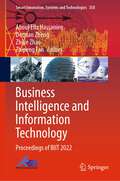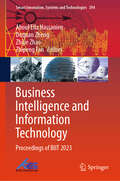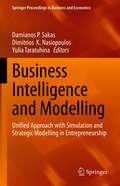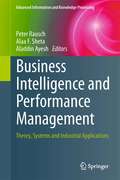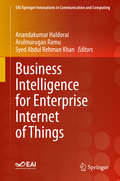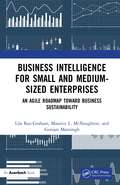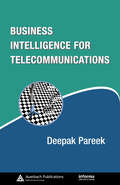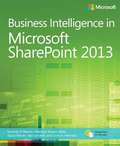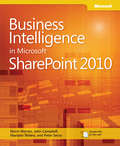- Table View
- List View
Business Information Systems and Technology 4.0: New Trends In The Age Of Digital Change (Studies In Systems, Decision And Control #141)
by Rolf DornbergerThis book discusses digitalization trends and their concrete applications in business and societal contexts. It summarizes new findings from research, teaching and management activities comprising digital transformation, e-business, the representation of knowledge, human–computer interaction and business optimization. The trends discussed include artificial intelligence, virtual reality, robotics, blockchain, and many more. Professors and researchers who conduct research and teach at the interface between academia and business present the latest advances in their field. The book adopts the philosophy of applied sciences and combines both rigorous research and practical applications. As such, it addresses the needs of both professors and researchers, who are constantly seeking inspiration, and of managers seeking to tap the potential of the latest trends to take their business to the next level. Readers will find answers to pressing questions that arise in their daily work.
Business Information Systems: 18th International Conference, BIS 2015, Poznań, Poland, June 24-26, 2015, Proceedings (Lecture Notes in Business Information Processing #208)
by Witold AbramowiczThis book contains the refereed proceedings of the 18th International Conference on Business Information Systems, BIS 2015, held in Pozna, Poland, in June 2015. The BIS conference series follows trends in academic and business research; thus, the theme of the BIS 2015 conference was "Making Big Data Smarter. " Big data is now a fairly mature concept, recognized and widely used by professionals in both research and industry. Together, they work on developing more adequate and efficient tools for data processing and analyzing, thus turning "big data" into "smart data. " The 26 revised full papers were carefully reviewed and selected from 70 submissions. In addition, two invited papers are included in this book. They are grouped into sections on big and smart data, semantic technologies, content retrieval and filtering, business process management and mining, collaboration, enterprise architecture and business−IT alignment, specific BIS applications, and open data for BIS.
Business Information Systems: 20th International Conference, BIS 2017, Poznan, Poland, June 28–30, 2017, Proceedings (Lecture Notes in Business Information Processing #288)
by Witold AbramowiczThis book constitutes the refereed proceedings of the 20th International Conference on Business Information Systems, BIS 2017, held in Poznań, Poland, in June 2017. Big Data Analytics helps to understand and enhance enterprises by linking many fields of information technology and business. This year’s conference theme was: Big Data Analytics for Business and Public Administration. The 24 full papers presented in this volume were carefully reviewed and selected from 72 submissions. They were organized in topical sections named: big and smart data; business and enterprise modeling; ICT project management; process management; smart infrastructure; and applications.
Business Information Systems: 21st International Conference, BIS 2018, Berlin, Germany, July 18-20, 2018, Proceedings (Lecture Notes in Business Information Processing #320)
by Witold Abramowicz Adrian PaschkeThis book constitutes the proceedings of the 21st International Conference on Business Information Systems, BIS 2018, held in Berlin, Germany, in July 2018. The BIS conference follows popular research trends, both in the academic and the business domain. Thus the theme of BIS 2018 was "Digital Transformation - An Imperative in Today's Business Markets". The 30 papers presented in this volume were carefully reviewed and selected from 96 submissions. They were organized in topical sections named: big and smart data and artificial intelligence; business and enterprise modeling; ICT project management; process management; smart infrastructures; social media and Web-based business information systems; applications, evaluations, and experiences.
Business Information Systems: 22nd International Conference, BIS 2019, Seville, Spain, June 26–28, 2019, Proceedings, Part I (Lecture Notes in Business Information Processing #353)
by Witold Abramowicz Rafael CorchueloThe two-volume set LNBIP 353 and 354 constitutes the proceedings of the 22nd International Conference on Business Information Systems, BIS 2019, held in Seville, Spain, in June 2019. The theme of the BIS 2019 was "Data Science for Business Information Systems", inspiring researchers to share theoretical and practical knowledge of the different aspects related to Data Science in enterprises. The 67 papers presented in these proceedings were carefully reviewed and selected from 223 submissions. The contributions were organized in topical sections as follows: Part I: Big Data and Data Science; Artificial Intelligence; ICT Project Management; and Smart Infrastructure. Part II: Social Media and Web-based Systems; and Applications, Evaluations and Experiences.
Business Information Systems: 22nd International Conference, BIS 2019, Seville, Spain, June 26–28, 2019, Proceedings, Part II (Lecture Notes in Business Information Processing #354)
by Witold Abramowicz Rafael CorchueloThe two-volume set LNBIP 353 and 354 constitutes the proceedings of the 22nd International Conference on Business Information Systems, BIS 2019, held in Seville, Spain, in June 2019. The theme of the BIS 2019 was "Data Science for Business Information Systems", inspiring researchers to share theoretical and practical knowledge of the different aspects related to Data Science in enterprises. The 67 papers presented in these proceedings were carefully reviewed and selected from 223 submissions. The contributions were organized in topical sections as follows: Part I: Big Data and Data Science; Artificial Intelligence; ICT Project Management; and Smart Infrastructure. Part II: Social Media and Web-based Systems; and Applications, Evaluations and Experiences.
Business Information Systems: 23rd International Conference, BIS 2020, Colorado Springs, CO, USA, June 8–10, 2020, Proceedings (Lecture Notes in Business Information Processing #389)
by Gary Klein Witold AbramowiczThis book constitutes the proceedings of the 23rd International Conference on Business Information Systems, BIS 2020, which was planned to take place in Colorado Springs, CO, USA. Due to the COVID-19 pandemic, the conference was held fully online during June 8–10, 2020. This year's theme was "Data Science and Security in Business Information Systems". The 30 contributions presented in this volume were carefully reviewed and selected from 86 submissions. The book also contains two contributions from BIS 2019. The papers were organized in the following topical sections: Data Security, Big Data and Data Science, Artificial Intelligence, ICT Project Management, Applications, Social Media, Smart Infrastructures.
Business Information Systems: 25th International Conference, BIS 2025, Poznań, Poland, June 25–27, 2025, Proceedings (Lecture Notes in Business Information Processing #554)
by Krzysztof WęcelThis book constitutes the proceedings of the 25th International Conference on Business Information Systems, BIS 2025, which took place in Poznan, Poland, during June 25-27, 2025. This year's theme was "AI-driven business transformation: challenges and opportunities". The 19 full papers and 4 short papers presented in this volume were carefully reviewed and selected from 54 submissions. The papers were organized in the following topical sections: Artificial intelligence in management; artificial intelligence for visualization; artificial intelligence for language processing; process mining; finance and privacy; data platforms and deployment; sustainable operations and smart automation.
Business Innovation for the Post-pandemic Era in Vietnam
by Hung Nguyen Nguyen Hoang Thuan Hiep Cong Pham Alrence HalibasThis book documents the recent post-pandemic era business innovation research in Vietnam bringing together selected works from the 2022 ‘International Conference on Business Innovation: Business Innovation in a Post-pandemic World’ held at RMIT University in Vietnam. The book contributes to the body of knowledge in several ways. It serves as a comprehensive reference for business innovation research and promotes recent progress in business innovation applications in Vietnam and offers a shared understanding to help coordinate future research in the field.
Business Intelligence
by Stacia Misner Elizabeth Vitt Michael Luckevich"This readable, practical book helps business people quickly understand what business intelligence is, how it works, where it's used, and why and when to use it--all illustrated by real case studies, not just theory." Nigel Pendse Author of The OLAP Report www.olapreport.com So much information, so little time. All too often, business data is hard to get at and use--thus slowing decision-making to a crawl. This insightful book illustrates how organizations can make better, faster decisions about their customers, partners, and operations by turning mountains of data into valuable business information that's always at the fingertips of decision makers. You'll learn what's involved in using business intelligence to bring together information, people, and technology to create successful business strategies--and how to execute those strategies with confidence. Topics covered include: THE BUSINESS INTELLIGENCE MINDSET: Discover the basics behind business intelligence, such as how it's defined, why and how to use it in your organization, and what characteristics, components, and general architecture most business intelligence solutions share. THE CASE FOR BUSINESS INTELLIGENCE: Read how world leaders in finance, manufacturing, and retail have successfully implemented business intelligence solutions and see what benefits they have reaped. THE PRACTICE OF BUSINESS INTELLIGENCE: Find out what's involved in implementing a business intelligence solution in your organization, including how to identify your business intelligence opportunities, what decisions you must make to get a business intelligence project going, and what to do to sustain the momentum so that you can continue to make sense of all the data you gather.
Business Intelligence & Analytics – Grundlagen und praktische Anwendungen: Ansätze der IT-basierten Entscheidungsunterstützung
by Henning Baars Hans-Georg KemperEine fundierte und praxisorientierte Einführung in die IT-basierte Managementunterstützung. Business Intelligence umfasst mehr als den Bereich Data Warehousing. Ziel ist die Realisierung eines Gesamtkonzeptes. Charakteristika sind eine konsistente, harmonisierte Datenhaltung, eine hohe Integrationsdichte der Analysesysteme und die Einbindung betriebswirtschaftlich anspruchsvoller Auswertungskonzepte. In dem Buch werden eine Business-Intelligence-Architektur sowie ein Vorgehensmodell zur Entwicklung integrierter BI-Anwendungssysteme entworfen und anhand von aussagekräftigen Praxisbeispielen ausführlich illustriert.
Business Intelligence (eXamen.press)
by Roland M. Müller Hans-Joachim LenzDas Buch befasst sich mit der Bereitstellung von Daten und Verfahren für analytische Zwecke (Planung, Entscheidung, Controlling sowie Fehlerrückverfolgung) in Unternehmen sowie der notwendigen Rechenleistungen. Die Autoren erläutern die Datenbereitstellung mittels Data Warehouses, Auswertung mittels OLAP-Operationalität und geeignete Verfahren der explorativen Datenanalyse. Bei den Verfahren des Operations Research werden Simulation und Lineare Optimierung dargestellt. Neben erfolgreichen Anwendungen und Fallstudien steht das Verständnis der zugrundeliegenden Algorithmen und Datenstrukturen, die für das Erlernen der BI-Verfahren zwingend notwendig sind, im Vordergrund.
Business Intelligence For Dummies
by Swain SchepsYou're intelligent, right? So you've already figured out that Business Intelligence can be pretty valuable in making the right decisions about your business. But you've heard at least a dozen definitions of what it is, and heard of at least that many BI tools. Where do you start?Business Intelligence For Dummies makes BI understandable! It takes you step by step through the technologies and the alphabet soup, so you can choose the right technology and implement a successful BI environment. You'll see how the applications and technologies work together to access, analyze, and present data that you can use to make better decisions about your products, customers, competitors, and more.You'll find out how to:Understand the principles and practical elements of BIDetermine what your business needsCompare different approaches to BIBuild a solid BI architecture and roadmapDesign, develop, and deploy your BI planRelate BI to data warehousing, ERP, CRM, and e-commerceAnalyze emerging trends and developing BI tools to see what else may be usefulWhether you're the business owner or the person charged with developing and implementing a BI strategy, checking out Business Intelligence For Dummies is a good business decision.
Business Intelligence and Big Data: 7th European Summer School, eBISS 2017, Bruxelles, Belgium, July 2–7, 2017, Tutorial Lectures (Lecture Notes in Business Information Processing #324)
by Esteban ZimányiThis book constitutes revised tutorial lectures of the 7th European Business Intelligence and Big Data Summer School, eBISS 2017, held in Bruxelles, Belgium, in July 2017. The tutorials were given by renowned experts and covered advanced aspects of business intelligence and big data. This summer school, presented by leading researchers in the field, represented an opportunity for postgraduate students to equip themselves with the theoretical, practical, and collaboration skills necessary for developing challenging business intelligence applications.
Business Intelligence and Big Data: Drivers of Organizational Success
by Celina M. OlszakThe twenty-first century is a time of intensifying competition and progressive digitization. Individual employees, managers, and entire organizations are under increasing pressure to succeed. The questions facing us today are: What does success mean? Is success a matter of chance and luck or perhaps is success a category that can be planned and properly supported? Business Intelligence and Big Data: Drivers of Organizational Success examines how the success of an organization largely depends on the ability to anticipate and quickly respond to challenges from the market, customers, and other stakeholders. Success is also associated with the potential to process and analyze a variety of information and the means to use modern information and communication technologies (ICTs). Success also requires creative behaviors and organizational cleverness from an organization. The book discusses business intelligence (BI) and Big Data (BD) issues in the context of modern management paradigms and organizational success. It presents a theoretically and empirically grounded investigation into BI and BD application in organizations and examines such issues as: Analysis and interpretation of the essence of BI and BD Decision support Potential areas of BI and BD utilization in organizations Factors determining success with using BI and BD The role of BI and BD in value creation for organizations Identifying barriers and constraints related to BI and BD design and implementation The book presents arguments and evidence confirming that BI and BD may be a trigger for making more effective decisions, improving business processes and business performance, and creating new business. The book proposes a comprehensive framework on how to design and use BI and BD to provide organizational success.
Business Intelligence and Data Analytics: Proceedings of BIDA 2024 (Smart Innovation, Systems and Technologies #413)
by Abhishek Verma Avinash Chandra Pandey Justin ZhangThis book is a collection of the high-quality research articles presented at the International Conference on Business Intelligence and Data Analytics (BIDA 2024), organized by RV Institute of Management (RVIM), Bengaluru, India, during April 2024. The book covers state-of-the-art research articles from the researchers and practitioners working in the field of business intelligence, data analytics, decision support systems, data warehousing and data mining, big data analytics, predictive and prescriptive analytics, and machine learning for business applications and their real-world applications.
Business Intelligence and Information Technology: Proceedings of BIIT 2022 (Smart Innovation, Systems and Technologies #358)
by Aboul Ella Hassanien Zhijie Zhao Zhipeng Fan Dequan ZhengThis book constitutes the refereed proceedings of the 2022 International Conference on Business Intelligence and Information Technology (BIIT 2022) held in Harbin, China, during December 17–18, 2022. BIIT 2022 is organized by the School of Computer and Information Engineering, Harbin University of Commerce, and supported by Scientific Research Group in Egypt (SRGE), Egypt. The papers cover current research in electronic commerce technology and application, business intelligence and decision making, digital economy, accounting informatization, intelligent information processing, image processing and multimedia technology, signal detection and processing, communication engineering and technology, information security, automatic control technique, data mining, software development, and design, blockchain technology, big data technology, and artificial intelligence technology.
Business Intelligence and Information Technology: Proceedings of BIIT 2023 (Smart Innovation, Systems and Technologies #394)
by Aboul Ella Hassanien Zhijie Zhao Zhipeng Fan Dequan ZhengThis book constitutes the refereed proceedings of the 2023 International Conference on Business Intelligence and Information Technology (BIIT 2023) held in Harbin, China, during December 16–17, 2023. BIIT 2023 is organized by the School of Computer and Information Engineering, Harbin University of Commerce, and supported by Scientific Research Group in Egypt (SRGE), Egypt. The papers cover current research in electronic commerce technology and application, business intelligence and decision making, digital economy, accounting informatization, intelligent information processing, image processing and multimedia technology, signal detection and processing, communication engineering and technology, information security, automatic control technique, data mining, software development, and design, blockchain technology, big data technology, and artificial intelligence technology.
Business Intelligence and Modelling: Unified Approach with Simulation and Strategic Modelling in Entrepreneurship (Springer Proceedings in Business and Economics)
by Damianos P. Sakas Dimitrios K. Nasiopoulos Yulia TaratuhinaThis book highlights interdisciplinary insights, latest research results, and technological trends in Business Intelligence and Modelling in fields such as: Business Intelligence, Business Transformation, Knowledge Dissemination & Implementation, Modeling for Logistics, Business Informatics, Business Model Innovation, Simulation Modelling, E-Business, Enterprise & Conceptual Modelling, etc. The book is divided into eight sections, grouping emerging marketing technologies together in a close examination of practices, problems and trends. The chapters have been written by researchers and practitioners that demonstrate a special orientation in Strategic Marketing and Business Intelligence. This volume shares their recent contributions to the field and showcases their exchange of insights.
Business Intelligence and Performance Management: Theory, Systems and Industrial Applications (Advanced Information and Knowledge Processing)
by Alaa F. Sheta Aladdin Ayesh Peter RauschDuring the 21st century business environments have become more complex and dynamic than ever before. Companies operate in a world of change influenced by globalisation, volatile markets, legal changes and technical progress. As a result, they have to handle growing volumes of data and therefore require fast storage, reliable data access, intelligent retrieval of information and automated decision-making mechanisms, all provided at the highest level of service quality. Successful enterprises are aware of these challenges and efficiently respond to the dynamic environment in which their business operates. Business Intelligence (BI) and Performance Management (PM) offer solutions to these challenges and provide techniques to enable effective business change. The important aspects of both topics are discussed within this state-of-the-art volume. It covers the strategic support, business applications, methodologies and technologies from the field, and explores the benefits, issues and challenges of each. Issues are analysed from many different perspectives, ranging from strategic management to data technologies, and the different subjects are complimented and illustrated by numerous examples of industrial applications. Contributions are authored by leading academics and practitioners representing various universities, research centres and companies worldwide. Their experience covers multiple disciplines and industries, including finance, construction, logistics, and public services, amongst others. Business Intelligence and Performance Management is a valuable source of reference for graduates approaching MSc or PhD programs and for professionals in industry researching in the fields of BI and PM for industrial application.
Business Intelligence for Enterprise Internet of Things (EAI/Springer Innovations in Communication and Computing)
by Syed Abdul Rehman Khan Anandakumar Haldorai Arulmurugan RamuThis book discusses Internet of Things (IoT) as it relates to enterprise applications, systems, and infrastructures. The authors discuss IoT and how it’s disrupting industries such as enterprise manufacturing, enterprise transportation, enterprise smart market, enterprise utilities, and enterprise healthcare. They cover how IoT in the enterprise will have a major impact on the lives of consumers and professionals around the world and how it will change the way we think about professional and consumer networks. The book's topics include IoT enterprise system architecture, IoT enabling enterprise technologies, and IoT enterprise services and applications. Examples include enterprise on demand, market impacts, and implications on smart technologies, big data enterprise management, and future enterprise Internet design for various IoT use cases, such as share markets, healthcare, smart cities, smart environments, smart communications and smart homes.
Business Intelligence for Small and Medium-Sized Enterprises: An Agile Roadmap toward Business Sustainability
by Gunjan Mansingh Lila Rao-Graham Maurice L. McNaughtonBusiness intelligence (BI) has evolved over several years as organizations have extended their online transaction processing (OLTP) capabilities and applications to support their routine operations. With online analytical processing (OLAP), organizations have also established the capability to extract internal and external data from a variety of sources to specifically obtain intelligence about non-routine and often less-structured arrangements. BI therefore refers to applications and technologies that are used to gather, provide access to, and analyze data and information about the operations of an organization. It has the capability of providing comprehensive insight into the more volatile factors affecting the business and its operations, thereby facilitating enhanced decision-making quality and contributing to the creation of business value. Larger and more sophisticated organizations have long been exploiting these capabilities. Business Intelligence for Small and Medium-Sized Enterprises (SMEs) guides SMEs in replicating this experience to provide an agile roadmap toward business sustainability. The book points out that successful BI implementations have generated significant increases in revenue and cost savings, however, the failure rates are also very high. More importantly, it emphasizes that a full range of BI capabilities is not the exclusive purview of large organizations. It shows how SMEs make extensive use of BI techniques to develop the kind of agility endowing them with the organizational capability to sense and respond to opportunities and threats in an increasingly dynamic business environment. It points to the way to a market environment in which smaller organizations could have a larger role. In particular, the book explains that by establishing the agility to leverage internal and external data and information assets, SMEs can enhance their competitiveness by having a comprehensive understanding of the key to an agile roadmap for business sustainability.
Business Intelligence for Telecommunications (Informa Telecoms & Media)
by Deepak PareekBringing together market research reports, business analyst briefings, and technology references into one comprehensive volume, Business Intelligence for Telecommunications identifies those advances in both methods and technology that are being employed to inform decision-making and give companies an edge in the rapidly growing and highly co
Business Intelligence in Microsoft SharePoint 2013
by Stacia Misner Scott A. Helmers Mariano Teixeira Neto Norman P. Warren Ivan SandersDive into the business intelligence features in SharePoint 2013--and use the right combination of tools to deliver compelling solutions. Take control of business intelligence (BI) with the tools offered by SharePoint 2013 and Microsoft SQL Server® 2012. Led by a group of BI and SharePoint experts, you'll get step-by-step instructions for understanding how to use these technologies best in specific BI scenarios--whether you're a SharePoint administrator, SQL Server developer, or business analyst. Discover how to: Manage the entire BI lifecycle, from determining key performance indicators to building dashboardsUse web-based Microsoft Excel® services and publish workbooks on a SharePoint Server Mash up data from multiple sources and create Data Analysis Expressions (DAX) using PowerPivot Create data-driven diagrams that provide interactive processes and context with Microsoft Visio® ServicesUse dashboards, scorecards, reports, and key performance indicators to monitor and analyze your business Use SharePoint to view BI reports side by side, no matter which tools were used to produced them
Business Intelligence in Microsoft® SharePoint® 2010
by Stacia Misner Mariano Teixeira Neto John Campbell Norman P. WarrenDive into the business intelligence (BI) features in SharePoint 2010--and use the right combination of tools to deliver compelling solutions. This practical guide helps you explore several BI application services available in SharePoint 2010 and Microsoft SQL Server® 2008 R2. You'll learn each technology with step-by-step instructions, and determine which ones work best in specific BI scenarios--whether you're a SharePoint administrator, SQL Server developer, or business analyst. Choose the BI tools that meet your needs--and learn how they work together Examine the BI lifecycle, from determining key performance indicators to building dashboards Take Microsoft Excel® further--gain more control and functionality with web-based Excel Services Mash up data from multiple sources using PowerPivot for Excel 2010 Create data visualizations with objects, context, and metrics using Microsoft Visio® Services Build dashboards, scorecards, and other monitoring and analysis tools with PerformancePoint® Services Use SharePoint to view BI reports side by side, no matter which tools were used to produced them Your companion web content includes: Interactive exercises that help you try out concepts or techniques Code samples that enable you to work with the exercises
